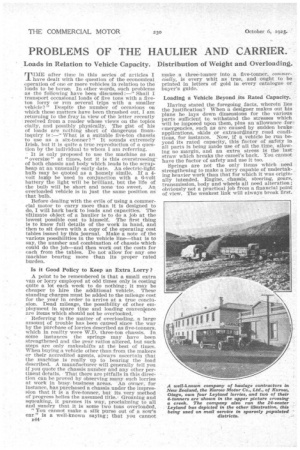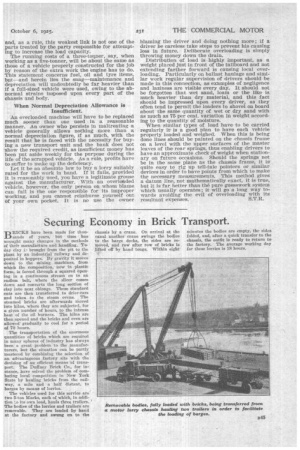PROBLEMS OF THE HAULIER AND CARRIER.
Page 28

Page 29

If you've noticed an error in this article please click here to report it so we can fix it.
Loads in Relation to Vehicle Capacity. Distribution of Weight and Overloading.
MIME after time in this series of articles I 1 have dealt with the question of the economical operation of one or more vehicles in relation to the loads to be borne: In other words, such problems as the following have been discussed:—" Shall transport occasional loads of five tons with a fiveton lorry or run several trips with a smaller vehicle? ' Despite the number of occasions on which these matters have been thrashed out, I am returning to the fray in view of the letter recently received from a reader whose views on the topics cially, and possibly physically, The gist of his of loads are nothing short of dangerqus finaninquiry is :—" What is a suitable five-ton chassis to use as a six-tonner? " It sounds extremely Irish. but it is quite a true reproduction of a question by the individual to whom I am referring, It is only proposed to use the machine as an " oversize " at times, but it is this overstressing' of of both chassis and body which leads to the scrapheap at an unusually early date. An electric-light bulb may be quoted as a homely simile. If a 4volt lamp be used in conjunction with a 6-volt battery the light will he brilliant, but the life of the bulb will be short and none too sweet. An overloaded vehicle is in just the same position a.g that bulb.
Before dealing with the evils of using a commercial motor to carry more than it is designed to do, I will hark back to loads and capacities. The ultimate object of a haulier is to do a job at the lowest possible cost to himself. The first thing is to know full details of the work in hand, and then to sit down with a copy of the operating cost tables issued by this journal. Make a note of the various possibilities in the vehicle line—that is to say, the number and combination of chassis which could do the job—and then work out the costs for each from the tables. Do not allow for any one machine bearing More than its proper rated burden.
Is it Good Policy to Keep an Extra Lorry ?
A point to be remembered is that a small extra van or lorry employed at odd times only is costing quite a lot each week to do nothing ; it may be cheaper to hire the additional vehicle. These standing charges must be added to the mileage cost for the year in order to arrive at a true cone-hi-Sion. Dead mileage, the possibility of other employment in spare time and loading convenience are items which should not be overlooked.
Referring to the matter of overloading, a large amount of trouble has been caused since the war by the purchase of lorries described as five-tonners, which in reality were W.D. three-ton chassis. In some instances the springs may have been strengthened and the gear ratios altered, but such steps are only makeshifts at the best of times. When buying .a vehicle other than from the makers or their accredited agents, always ascertain that the machine is 'really up to bearing the load described. A manufacturer will generally tell you if you quote the chassis number and any other pertinent details. That there are pitfalls in this direction can be proved by observing many such lorries at work in busy business areas. An owner, for instance, has purchased a chassis under the impression that it is a five-tonner, but its very method of progress belieS the assumed title. Groaning and squeaking, it pursues its way, proclaiming to all and sundry that it is some two tons overloaded.
"You cannot make a silk purse out of a sow's ear" is a well-known saying; that you cannot
B44, make a three-tonner into a five-tonner, commercially, is every whit as true, and ought to be printed in letters of gold in every catalogue or buyer's guide.
Loading a Vehicle Beyond its Rated Capacity.
Having stated the foregoing facts, wherein lies the justification? When a designer makes out his plans he lays down dimensions for the various parts sufficient to withstand the stresses which will be imposed upon them, plus an 'allowance for' emergencies, such as are caused by sudden brake applications, skids or extraordinary road conditions, for instance. Now, if a vehicle be run beyond its rated capacity, this factor of safety in all parts is being made use of all the .time, allowing no margin, and an extra stress is the last straw which breaks the camel's back. You cannot have the factor of safety and use it too. Springs are not the only items which need strengthening to make a lorry capable of undertaking heavier work than that for which it was originally intended. Engine, chassis, steering, gears, transmission, body and wheels all need alteration; obviously not a practical job from a financial point of view. The weakest link will always break first. and, as a rule, this weakest link is not one of the parts treated by the party responsible for attempting to increase the load capacity.
The running costs of a three-tonner, say, when working as a five-tonner, will be about the same as those of a vehicle properly constructed for the job by reason of the extra work the engine has to do. This statement concerns fuel, oil and tyre items, but—and herein lies the snag—maintenance and depreciation will undoubtedly be far heavier than If a full-sized vehicle were used, owing to the abnormal strains imposed upon every part of the chassis and body.
When Normal Depreciation Allowance is Insufficient.
An overloaded ma chine will have to be replaced much sooner than one used in a reasonable manner. An owner who persists in maltreating a vehicle generally allows nothing more than a normal depreciation figure, if as much, with the result that he is faced with the necessity for buying a new transport unit and the bank does not show the required credit, as insufficient money has been put aside weekly for the purpose during the life of the scrapped vehicle. As a rule, profits have to suffer to make up the deficiency.
Let it be an absolute law to buy a lorry suitably rated for the work in hand. If it fails, provided it is reasonably used, you have a legitimate grouse against the manufacturer. With an overloaded vehicle, however, the only person on whom blame can fall is the one responsible for its improper working, and you cannot reimburse yourself outof your own pocket. It is no use the owner blaming the driver and doing nothing more ; if a driver be careless take steps to prevent his causing loss in future. Deliberate overloading is simply throwing money down the drain.
Distribution of load is highly important, as a weight placed just in front of the tailboard and not extending farther forward is causing local overloading. Particularly on ballast haulage and similar work regular supervision of drivers should be made in this connection, as examples of negligence and laziness are visible every day. It should not be forgotten that wet sand, loam or the like is much heavier than dry material, and this fact should be impressed upon every driver, as they often tend to permit the loaders to shovel on board about the same quantity of wet or dry sand with as much as 76 per cent. variation in weight according to the quantity of moisture.
When similar types of load have to be carried regularly it is a good plan to have each vehicle properly loaded and weighed. When this is being done lines should be painted on the chassis frame on a level with the upper surfaces of the master leaves of the rear springs, thus enabling drivers to have an approximate check of weight when stationary on future occasions. Should the springs not be in the same plane as the chassis frame, it hr quite easy to rig up tell-tale pointers or similar devices in order to have points from which to make the necessary measurements. This method gives a datum line, not mathematically exact, it is true, but it is far better than the pure guesswork system which usually operates ; it will go a long way towards avoiding the evil of overloading with its
resultant expenses. S.T.R.
































